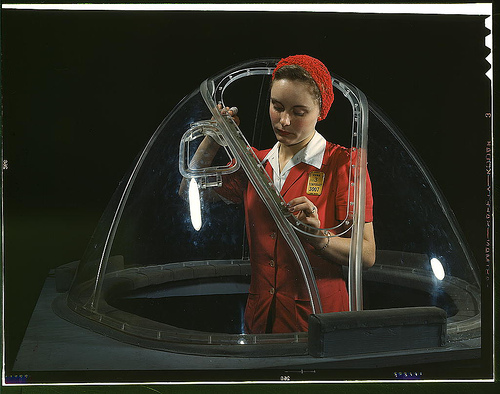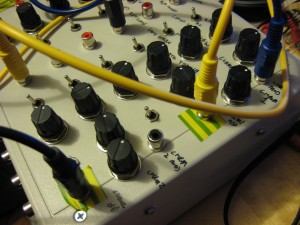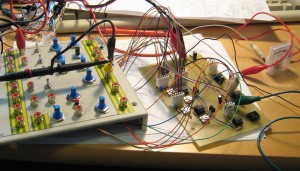-
Video bends on film
Posted on March 30th, 2010 No commentsNice documentary about the last circuit bending workshop at South Hill Park. I am in the middle talking about video circuit bending with a few demos too.
-
The Lushprojects Business Card
Posted on March 23rd, 2010 No commentsA lot of people ask me about the above photo which appears on the Lushprojects business card. Here is the original description:
Palmer, Alfred T.,, photographer.
This girl in a glass house is putting finishing touches on the bombardier nose section of a B-17F navy bomber, Long Beach, Calif. She’s one of many capable women workers in the Douglas Aircraft Company plant. Better known as the “Flying Fortress,” the B-17F is a later model of the B-17 which distinguished itself in action in the South Pacific, over Germany and elsewhere. It is a long range, high altitude heavy bomber, with a crew of seven to nine men, and with armament sufficient to defend itself on daylight missions
1942 Oct.
It’s from the US Library of Congress collection on Flicker.
The series is visually beautiful and must have been originally created as propaganda tools. I like its enigmatic quality if taken out of context.
-
Extra bends on GSC AVEP2S
Posted on March 23rd, 2010 No commentsThe circuit-bent AVEP2S is still my favourite video tool. I was looking at some other video circuit benders work and liked a lot of stuff they were doing with chroma keys and control of saturation in an image. This inspired me to go back to the AVEP2S and add a few other nice features.
The first project was to add some simple chroma key functions. The signals that were easily available to do this are the PAL colour components “(R-Y)” and “(B-Y)” so they aren’t real chroma keys because there is a big component of luminance in them too. Still they help slice up the image. The keying circuit is built from a uA733 video amp (from the arc) to boost the signals feeding in to a comparator. I found the 733 amp really hard to work with – it seems very sensitive to DC biasing and impedance on the output. Any advice from readers on how to make effective use of this IC is welcome.
The other mod was to provide an input that can override the manual colour saturation control so that output can be varied dynamically.
With the additional keys you can get some really nice effects – particularly as you can modulate the key with an audio signal.
-
Videobending Utility Functions
Posted on March 22nd, 2010 No commentsI’ve used the spare half of the Down The Bar case to house some utility functions that are useful for getting effects on video bends.
The functions are:
- Two voltage controlled amplifiers based on this design
- Sum/difference amplifier for the output of the two VCAs
- Schmitt trigger with controllable threshold and hysteresis
- Analog meters to show the DC level and AC level of the output from the sum/difference amp
Two 555-based LFOs
With all this to hand the you can create a lot richer effects, and the LFOs allow some “hands free” dynamic effects.
-
Inside a security camera (mostly air)
Posted on March 22nd, 2010 No commentsFor the video bending project I’ve been using a couple of CCD-based security cameras off eBay. They come in nice metal cases and have great performance in low light. The low resolution of the sensor rather spoils the picture quality though, but that’s not much of an issue once you start adding circuit bent mixers.
After a recent gig I noticed that the BNC socket on the back of one of the cameras had been damaged. As I prefer to use phono sockets I decided to take the damaged BNC off and replace it.
So, what’s inside these security cameras? The answer is “mostly air”. There are two little boards at each end and then a long camera body to make it look more substantial.
Just to show how little there is there – here is the whole camera working without its case. Moral of the story – don’t assume that bigger is better!
Another interesting thing I learnt about these cameras is how the iris control on the lens works. It turns out there are only two iris settings – if you set the switch on the back to “indoor” mode then the iris is fully open. If you set it to “outdoor” then the iris is fully closed.








